计算机专业英语大作业
- 格式:doc
- 大小:67.00 KB
- 文档页数:9

计算机英语作业(一)班级:2011计本班姓名:程振宁、孙嘉仪学号:01、02Lost Lessons from 8-Bit BASIC失去8-Bit BASIC的教训Unstructured programming with GOTO is the stuff of legend, as are calling subroutines by line number--GOSUB 1000--and setting global variables as a mechanism for passing parameters.作为被调用子程序的行号--GOSUB 1000--和设置全局变量的机制传递参数,非结构化编程GOTO语句可以说是传说中的东西。
The little language that fueled the home computer revolution has been long buried beneath an avalanche of derision, or at least disregarded as a relic from primitive times. That's too bad, because while the language itself has serious shortcomings, the overall 8-bit BASIC experience has high points that are worth remembering.这个小语句,推动了家用电脑已经长埋在雪崩之下的革命,或者说至少藐视了那些远古的遗物。
这一点非常不好,因为虽然语言本身存在严重缺陷,但整个8位基础的编程经验还是有很多值得我们铭记的地方。
It's hard to separate the language and the computers it ran it on; flipping the power switch, even without a disk drive attached, resulted in a BASIC prompt. If nothing else, it could be treated as a calculator:PRINT "seconds in a week: ",60*60*24*7orPRINT COS(2)/2Notice how the cosine function is always available for use. No importing a library. No qualifying it with MATH.TRIG. 我们很难将这些允许在计算机上与语言分开;打开计算机电源开关,即使没有磁盘驱动器连接,也会产生基本的提示符;如果不出意外,我们可以将它视为一个计算器:输出“一周有多少秒”,60*60*24*7或者输出 COS(2)/2注意如何余弦函数必须是可解的。
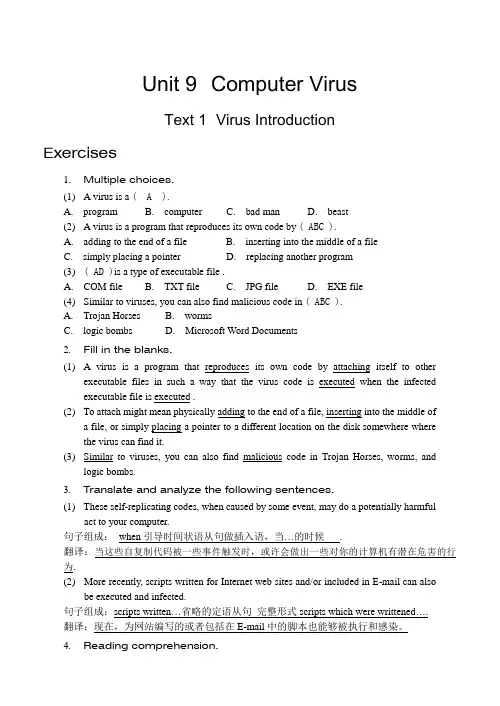
Unit 9 Computer VirusText 1 Virus IntroductionExercises1. Multiple choices.(1)A virus is a ( A ).A. programB. computerC. bad manD. beast(2)A virus is a program that reproduces its own code by ( ABC ).A. adding to the end of a fileB. inserting into the middle of a fileC. simply placing a pointerD. replacing another program(3)( AD )is a type of executable file .A. COM fileB. TXT fileC. JPG fileD. EXE file(4)Similar to viruses, you can also find malicious code in ( ABC ).A. Trojan HorsesB. wormsC. logic bombsD. Microsoft Word Documents2. Fill in the blanks.(1)A virus is a program that reproduces its own code by attaching itself to otherexecutable files in such a way that the virus code is executed when the infectedexecutable file is executed .(2)To attach might mean physically adding to the end of a file, inserting into the middle ofa file, or simply placing a pointer to a different location on the disk somewhere wherethe virus can find it.(3)Similar to viruses, you can also find malicious code in Trojan Horses, worms, andlogic bombs.3. Translate and analyze the following sentences.(1)These self-replicating codes, when caused by some event, may do a potentially harmfula ct to your computer.句子组成:when引导时间状语从句做插入语,当…的时候.翻译:当这些自复制代码被一些事件触发时,或许会做出一些对你的计算机有潜在危害的行为.(2)M ore recently, scripts written for Internet web sites and/or included in E-mail can alsob e executed and infected.句子组成:scripts written…省略的定语从句完整形式scripts which were writtened….翻译:现在,为网站编写的或者包括在E-mail中的脚本也能够被执行和感染。
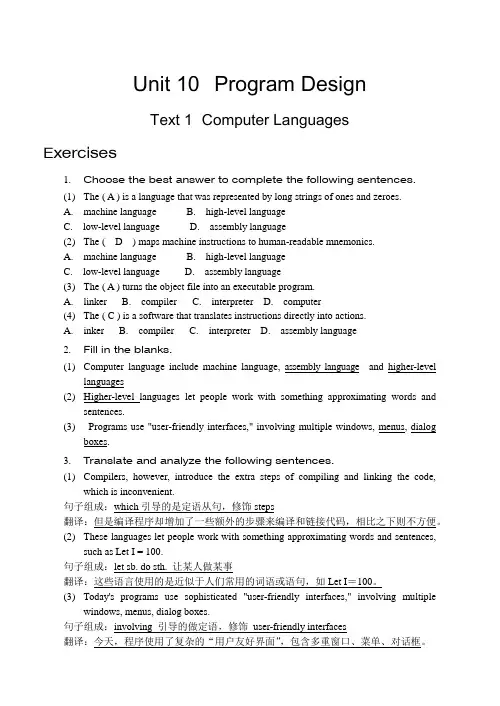
Unit 10 Program DesignText 1 Computer LanguagesExercises1. Choose the best answer to complete the following sentences.(1)The ( A ) is a language that was represented by long strings of ones and zeroes.A. machine languageB. high-level languageC. low-level languageD. assembly language(2)The ( D ) maps machine instructions to human-readable mnemonics.A. machine languageB. high-level languageC. low-level languageD. assembly language(3)The ( A ) turns the object file into an executable program.A. linkerB. compilerC. interpreterD. computer(4)The ( C ) is a software that translates instructions directly into actions.A. inkerB. compilerC. interpreterD. assembly language2. Fill in the blanks.(1)Computer language include machine language, assembly language and higher-levellanguages(2)Higher-level languages let people work with something approximating words andsentences.(3)Programs use "user-friendly interfaces," involving multiple windows, menus, dialogboxes.3. Translate and analyze the following sentences.(1)Compilers, however, introduce the extra steps of compiling and linking the code,which is inconvenient.句子组成:which引导的是定语从句,修饰steps翻译:但是编译程序却增加了一些额外的步骤来编译和链接代码,相比之下则不方便。
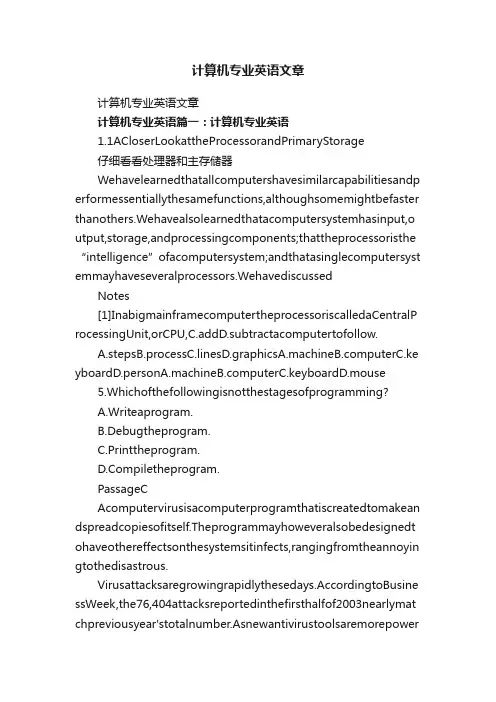
计算机专业英语文章计算机专业英语文章计算机专业英语篇一:计算机专业英语1.1ACloserLookattheProcessorandPrimaryStorage仔细看看处理器和主存储器Wehavelearnedthatallcomputershavesimilarcapabilitiesandp erformessentiallythesamefunctions,althoughsomemightbefaster thanothers.Wehavealsolearnedthatacomputersystemhasinput,o utput,storage,andprocessingcomponents;thattheprocessoristhe “intelligence”ofacomputer system;andthatasinglecomputersyst emmayhaveseveralprocessors.WehavediscussedNotes[1]InabigmainframecomputertheprocessoriscalledaCentralP rocessingUnit,orCPU,C.addD.subtractacomputertofollow.A.stepsB.processC.linesputerC.ke puterC.keyboardD.mouse5.Whichofthefollowingisnotthestagesofprogramming?A.Writeaprogram.B.Debugtheprogram.C.Printtheprogram.piletheprogram.PassageCAcomputervirusisacomputerprogramthatiscreatedtomakean dspreadcopiesofitself.Theprogrammayhoweveralsobedesignedt ohaveothereffectsonthesystemsitinfects,rangingfromtheannoyin gtothedisastrous.Virusattacksaregrowingrapidlythesedays.AccordingtoBusine ssWeek,the76,404attacksreportedinthefirsthalfof2003nearlymat chpreviousyear'stotalnumber.Asnewantivirustoolsaremorepowerfulthanbefore,theviruswritersaregettingalotsmarterwithneweran dcreativewaystoattacknetworksystems.Let'sfirstexaminesomeco mmonvirustypes:BasicVirus-apieceofsoftwarecodethatisdevelopedtoattackcomputersandnet worksystemsviaemailorInternetconnections.Itquicklyreplicatesits elfandgraduallyattachestofiles,programsortheharddrive.TrojanHorses-Thisisaprogramthatdoesn'treplicatewhenenteringasystembutcan beeffectivelyusedtoopen'backdoors.'TrojanHorsesallowhackerst otakecontroloveraparticularsystemortostealveryimportantdata.Worm-thistypeofvirusisabletospreaditselfautomaticallyoverthenetworkf romonecomputertothenext.Duringawormattack,users'computer sgetinfectedwithoutevenhavingtoclickopenemailattachmentora nyprogram,etc.Sinceitisverydifficulttoavoidthevirus,yourbestdefenseisapow erfulantivirusprogram.Inordertofightwithsuchviruses,thesoftwar evendorsshouldfocusonmakingtheirproductsmorerobust.Thisma yaskforatrade-offbetweenuser-friendlinessandsecurity.Inspecificcasesitmayrequireline-by-lineinspection,coderetoolingandevensystemsautomationtodefen dtheinstalledprograms.(四)、choosethebestansweraccordingtothepassageB.(根据上文的内容选择正确的答案。
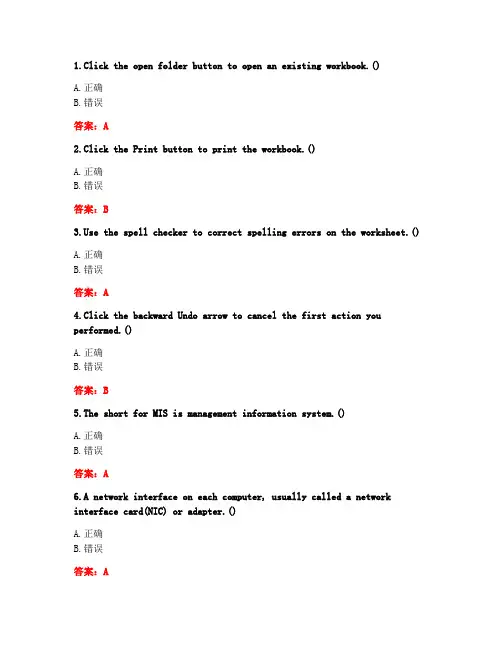
1.Click the open folder button to open an existing workbook.()A.正确B.错误答案:A2.Click the Print button to print the workbook.()A.正确B.错误答案:Be the spell checker to correct spelling errors on the worksheet.()A.正确B.错误答案:A4.Click the backward Undo arrow to cancel the first action you performed.()A.正确B.错误答案:B5.The short for MIS is management information system.()A.正确B.错误答案:A6.A network interface on each computer, usually called a network interface card(NIC) or adapter.()A.正确B.错误答案:A7.FTP performs basic interactive file transfers between hosts.()A.正确B.错误答案:A8.Telnet enables users to cute terminal sessions with local hosts.()A.正确B.错误答案:B9.Most networks-even those with just two computers also contain a hub or switch to act as a connection point between the computers.()A.正确B.错误答案:A10.A VPN offers the security and full data access of a private WAN, but because it runs over the Internet, it is more affordable and complex.()A.正确B.错误答案:A11.Microsoft Office 2000 includes Word, _____, Outlook and FrontPage.A.ExcelB.Power PointC.AccessD.All of the above答案:D12.ERP is _____.A.Enterprise resource planning softwareB.Enterprise Application IntegrationC.Electronic Application IntegrationD.None of the above.答案:A13._____ is an operating system similar to Unix.A.Windows NTB.MS-DOSC.OS/2D.Linux答案:D14.A backup program _____.A.makes a copy of files you selectB.returns you to the previous programC.undoes the last change you madeD.None of the above答案:A15.TCP/IP refers to a suite of _____.A.systemB.control unitsC.application programsD.data communication protocols答案:D16.TCP/IP application layer protocols include the following except _____.A.HTTPB.FTPC.UDPD.Telnet答案:C17._____ provides reliable, full-duplex connections and reliable service by ensuring that data is resubmitted when transmission results in an error.A.TCPB.ARPC.UDPD.IP答案:A18._____ layer just above the internet layer.work InterfaceB.TCPC.Host-to-Host TransportD.Application答案:C19._____ are collections of two or more connected computers.A.VPNB.ModemworksD.Cable答案:C20.We abbreviate Virtual Private Networks to _____.A.NICB.VPNC.HUBD.MODEM答案:B。
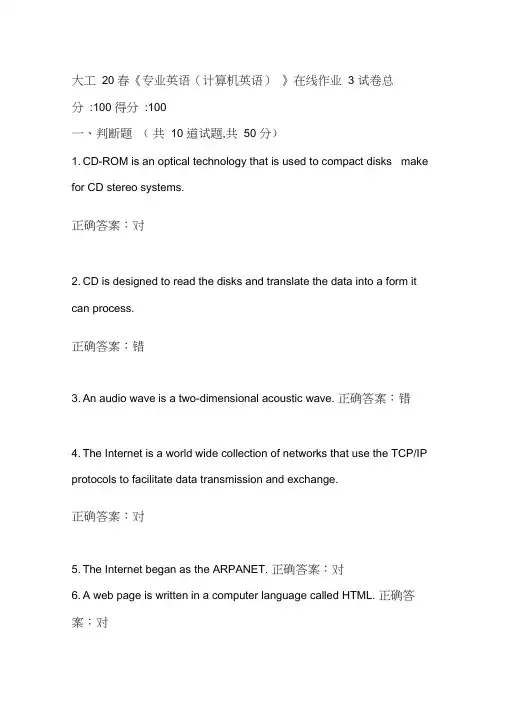
大工20 春《专业英语(计算机英语)》在线作业 3 试卷总分:100 得分:100一、判断题(共10 道试题,共50 分)1. CD-ROM is an optical technology that is used to compact disksmake for CD stereo systems.正确答案:对2. CD is designed to read the disks and translate the data into a form it can process.正确答案:错3. An audio wave is a two-dimensional acoustic wave. 正确答案:错4. The Internet is a world wide collection of networks that use the TCP/IP protocols to facilitate data transmission and exchange.正确答案:对5. The Internet began as the ARPANET. 正确答案:对6. A web page is written in a computer language called HTML. 正确答案:对7. Each web page has a unique address, called a URL that identifies its location on the network.正确答案:对8. C is an object-oriented programming language. 正确答案:错9. A program is a set of words and symbols that allow a programmer to tell the computer what operations to follow. 正确答案:对10.ICQ is a popular software program for chats can be downloaded for free from the ICQ website. 正确答案:对二、单选题(共10 道试题,共50 分)11. Which one is an image-editing tool?A. P hotoshopB. W ordC. Extreme 3DD. Premiere正确答案:A12. Which one is a sound-editing tool?A. P hotoshopB. W avestudioC. Extreme 3DD. Premiere 正确答案: B13. Which of the following is nota format for a graphical image file?A. B MP fileB. G IF fileC. JPG fileD. AVI file 正确答案: D14. ( ) is a compiled object-oriented programming language used to write applets.A. CB. C++C. JavaScriptD. Java 正确答案: D15. A ( ) is a collection of relation fields.A. f ieldB. r ecordC. characterD. file正确答案:D16. Database management system(DBMS) programs are designed to work with data that is logically structured or arranged in a particular way, known as ( ).A. d ata modelB. d atabaseC. informationD. data正确答案:A17. ( ) is a database management system from Microsoft, packaged with Microsoft Office.A. M icrosoft SQL ServerB. D B2C. Microsoft AccessD. Informix正确答案:C18. To protect data, you need to implement a data ( recovery) and plan.A. m odifyB. b ackupC. deleteD. All above正确答案:B19. ( ) is an outline of the logic of the program you will write.A. P rogram flowchartsB. L ogic structuresC. PseudocodeD. Design 正确答案: A20. A ( ) converts the programmer's procedural language program, called the source code, into a machine language code, called the object code.A. C ompilerB. A ssemblerC. InterpreterD. Code generator 正确答案: A。
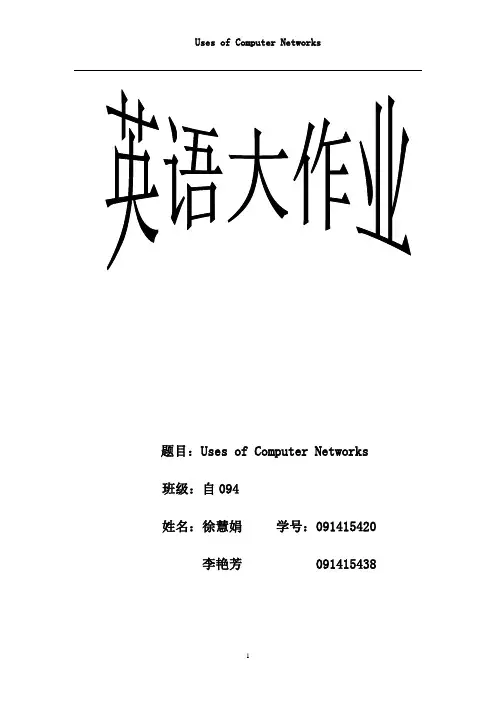
题目:Uses of Computer Networks 班级:自094姓名:徐慧娟学号:091415420 李艳芳 091415438Uses of Computer NetworksBefore we start to examine the technical issues in detail, it is worth devoting some time to pointing out why people are interested in computer networks and what they can be used for. After all, if nobody were interested in computer networks, few of them would be built. We will start with traditional uses at companies and for individuals and then move on to recent developments regarding mobile users and home networking.1. Business ApplicationsMany companies have a substantial number of computers. For example, a company may have separate computers to monitor production, keep track of inventories, and do the payroll. Initially, each of these computers may have worked in isolation from the others, but at some point, management may have decided to connect them to be able to extract and correlate information about the entire company.Put in slightly more general form, the issue here is resource sharing, and the goal is to make all programs, equipment, and especially data available to anyone on the network without regard to the physical location of the resource and the user. An obvious and widespread example is having a group of office workers share a common printer. None of the individuals really needs a private printer, and a high-volume networked printer is often cheaper, faster, and easier to maintain than a large collection of individual printers.However, probably even more important than sharing physical resources such as printers, scanners, and CD burners, is sharing information. Every large and medium-sized company and many small companies are vitally dependent on computerized information. Most companies have customer records, inventories, accounts receivable, financial statements, tax information, and much more online. If all of its computers went down, a bank could not last more than five minutes. A modern manufacturing plant, with a computer-controlled assembly line, would not last even that long. Even a small travel agency or three-person law firm is now highly dependent on computer networks for allowing employees to access relevant information and documents instantly.For smaller companies, all the computers are likely to be in a single office or perhaps a single building, but for larger ones, the computers and employees may be scattered over dozens of offices and plants in many countries. Nevertheless, a sales person in New York might sometimes need access to a product inventory database in Singapore. In other words, themere fact that a user happens to be 15,000 km away from his data should not prevent him from using the data as though they were local. This goal may be summarized by saying that it is an attempt to end the ''tyranny of geography.''In the simplest of terms, one can imagine a company's information system as consisting of one or more databases and some number of employees who need to access them remotely. In this model, the data are stored on powerful computers called servers. Often these are centrally housed and maintained by a system administrator. In contrast, the employees have simpler machines, called clients, on their desks, with which they access remote data, for example, to include in spreadsheets they are constructing. (Sometimes we will refer to the human user of the client machine as the ''client,'' but it should be clear from the context whether we mean the computer or its user.) The client and server machines are connected by a network, as illustrated in Fig. 1-1. Note that we have shown the network as a simple oval, without any detail. We will use this form when we mean a network in the abstract sense. When more detail is required, it will be provided.Figure 1-1. A network with two clients and one server.This whole arrangement is called the client-server model. It is widely used and forms the basis of much network usage. It is applicable when the client and server are both in the same building (e.g., belong to the same company), but also when they are far apart. For example, when a person at home accesses a page on the World Wide Web, the same model is employed, with the remote Web server being the server and the user's personal computer being the client. Under most conditions, one server can handle a large number of clients.If we look at the client-server model in detail, we see that two processes are involved, one on the client machine and one on the server machine. Communication takes the form of the client process sending amessage over the network to the server process. The client process then waits for a reply message. When the server process gets the request, it performs the requested work or looks up the requested data and sends back a reply. These messages are shown in Fig. 1-2.Figure 1-2. The client-server model involves requests and replies.A second goal of setting up a computer network has to do with people rather than information or even computers. A computer network can provide a powerful communication medium among employees. Virtually every company that has two or more computers now has e-mail (electronic mail), which employees generally use for a great deal of daily communication. In fact, a common gripe around the water cooler is how much e-mail everyone has to deal with, much of it meaningless because bosses have discovered that they can send the same (often content-free) message to all their subordinates at the push of a button.But e-mail is not the only form of improved communication made possible by computer networks. With a network, it is easy for two or more people who work far apart to write a report together. When one worker makes a change to an online document, the others can see the change immediately, instead of waiting several days for a letter. Such a speedup makes cooperation among far-flung groups of people easy where it previously had been impossible.Yet another form of computer-assisted communication is videoconferencing. Using this technology, employees at distant locations can hold a meeting, seeing and hearing each other and even writing on a shared virtual blackboard. Videoconferencing is a powerful tool for eliminating the cost and time previously devoted to travel. It is sometimes said that communication and transportation are having a race, and whichever wins will make the other obsolete.A third goal for increasingly many companies is doing business electronically with other companies, especially suppliers and customers. For example, manufacturers of automobiles, aircraft, and computers, among others, buy subsystems from a variety of suppliers and then assemble the parts. Using computer networks, manufacturers can place orderselectronically as needed. Being able to place orders in real time (i.e., as needed) reduces the need for large inventories and enhances efficiency.A fourth goal that is starting to become more important is doing business with consumers over the Internet. Airlines, bookstores, and music vendors have discovered that many customers like the convenience of shopping from home. Consequently, many companies provide catalogs of their goods and services online and take orders on-line. This sector is expected to grow quickly in the future. It is called e-commerce (electronic commerce).2. Home ApplicationsIn 1977, Ken Olsen was president of the Digital Equipment Corporation, then the number two computer vendor in the world (after IBM). When asked why Digital was not going after the personal computer market in a big way, he said: ''There is no reason for any individual to have a computer in his home.'' History showed otherwise and Digital no longer exists. Why do people buy computers for home use? Initially, for word processing and games, but in recent years that picture has changed radically. Probably the biggest reason now is for Internet access. Some of the more popular uses of the Internet for home users are as follows:1.Access to remote information.2.Person-to-person communication.3.Interactive entertainment.4.Electronic commerce.Access to remote information comes in many forms. It can be surfing the World Wide Web for information or just for fun. Information available includes the arts, business, cooking, government, health, history, hobbies, recreation, science, sports, travel, and many others. Fun comes in too many ways to mention, plus some ways that are better left unmentioned.Many newspapers have gone on-line and can be personalized. For example, it is sometimes possible to tell a newspaper that you want everything about corrupt politicians, big fires, scandals involving celebrities, and epidemics, but no football, thank you. Sometimes it is even possible to have the selected articles downloaded to your hard disk while you sleep or printed on your printer just before breakfast. As this trend continues, it will cause massive unemployment among 12-year-old paperboys, but newspapers like it because distribution has always been the weakest link in the whole production chain.The next step beyond newspapers (plus magazines and scientific journals) is the on-line digital library. Many professional organizations, such as the ACM () and the IEEE Computer Society (), already have many journals and conference proceedings on-line. Other groups are following rapidly. Depending on the cost, size, and weight of book-sized notebook computers, printed books may become obsolete. Skeptics should take note of the effect the printing press had on the medieval illuminated manuscript.All of the above applications involve interactions between a person and a remote database full of information. The second broad category of network use is person-to-person communication, basically the 21st century's answer to the 19th century's telephone. E-mail is already used on a daily basis by millions of people all over the world and its use is growing rapidly. It already routinely contains audio and video as well as text and pictures. Smell may take a while.Any teenager worth his or her salt is addicted to instant messaging. This facility, derived from the UNIX talk program in use since around 1970, allows two people to type messages at each other in real time. A multiperson version of this idea is the chat room, in which a group of people can type messages for all to see.Worldwide newsgroups, with discussions on every conceivable topic, are already commonplace among a select group of people, and this phenomenon will grow to include the population at large. These discussions, in which one person posts a message and all the other subscribers to the newsgroup can read it, run the gamut from humorous to impassioned. Unlike chat rooms, newsgroups are not real time and messages are saved so that when someone comes back from vacation, all messages that have been posted in the meanwhile are patiently waiting for reading.Another type of person-to-person communication often goes by the name of peer-to-peer communication, to distinguish it from the client-server model (Parameswaran et al., 2001). In this form, individuals who form a loose group can communicate with others in the group, as shown in Fig. 1-3. Every person can, in principle, communicate with one or more other people; there is no fixed division into clients and servers.Figure 1-3. In a peer-to-peer system there are no fixed clients and servers.Peer-to-peer communication really hit the big time around 2000 with a service called Napster, which at its peak had over 50 million music fans swapping music, in what was probably the biggest copyright infringement in all of recorded history (Lam and Tan, 2001; and Macedonia, 2000). The idea was fairly simple. Members registered the music they had on their hard disks in a central database maintained on the Napster server. If a member wanted a song, he checked the database to see who had it and went directly there to get it. By not actually keeping any music on its machines, Napster argued that it was not infringing anyone's copyright. The courts did not agree and shut it down.However, the next generation of peer-to-peer systems eliminates the central database by having each user maintain his own database locally, as well as providing a list of other nearby people who are members of the system. A new user can then go to any existing member to see what he has and get a list of other members to inspect for more music and more names. This lookup process can be repeated indefinitely to build up a large local database of what is out there. It is an activity that would get tedious for people but is one at which computers excel.Legal applications for peer-to-peer communication also exist. For example, fans sharing public domain music or sample tracks that new bands have released for publicity purposes, families sharing photos, movies, and genealogical information, and teenagers playing multiperson on-line games. In fact, one of the most popular Internet applications of all, e-mail, is inherently peer-to-peer. This form of communication is expected to grow considerably in the future.Electronic crime is not restricted to copyright law. Another hot area is electronic gambling. Computers have been simulating things for decades. Why not simulate slot machines, roulette wheels, blackjack dealers, and more gambling equipment? Well, because it is illegal in a lot of places.The trouble is, gambling is legal in a lot of other places (England, for example) and casino owners there have grasped the potential for Internet gambling. What happens if the gambler and the casino are in different countries, with conflicting laws? Good question.Other communication-oriented applications include using the Internet to carry telephone calls, video phone, and Internet radio, three rapidly growing areas. Another application is telelearning, meaning attending 8 A.M. classes without the inconvenience of having to get out of bed first. In the long run, the use of networks to enhance human-to-human communication may prove more important than any of the others.Our third category is entertainment, which is a huge and growing industry. The killer application here (the one that may drive all the rest) is video on demand. A decade or so hence, it may be possible to select any movie or television program ever made, in any country, and have it displayed on your screen instantly. New films may become interactive, where the user is occasionally prompted for the story direction (should Macbeth murder Duncan or just bide his time?) with alternative scenarios provided for all cases. Live television may also become interactive, with the audience participating in quiz shows, choosing among contestants, and so on.On the other hand, maybe the killer application will not be video on demand. Maybe it will be game playing. Already we have multiperson real-time simulation games, like hide-and-seek in a virtual dungeon, and flight simulators with the players on one team trying to shoot down the players on the opposing team. If games are played with goggles and three-dimensional real-time, photographic-quality moving images, we have a kind of worldwide shared virtual reality.Our fourth category is electronic commerce in the broadest sense of the term. Home shopping is already popular and enables users to inspect the on-line catalogs of thousands of companies. Some of these catalogs will soon provide the ability to get an instant video on any product by just clicking on the product's name. After the customer buys a product electronically but cannot figure out how to use it, on-line technical support may be consulted.Another area in which e-commerce is already happening is access to financial institutions. Many people already pay their bills, manage their bank accounts, and handle their investments electronically. This will surely grow as networks become more secure.One area that virtually nobody foresaw is electronic flea markets (e-flea?). On-line auctions of second-hand goods have become a massive industry. Unlike traditional e-commerce, which follows the client-server model, on-line auctions are more of a peer-to-peer system, sort of consumer-to-consumer. Some of these forms of e-commerce have acquired cute little tags based on the fact that ''to'' and ''2'' are pronounced the same. The most popular ones are listed in Fig. 1-4.Figure 1-4. Some forms of e-commerce.No doubt the range of uses of computer networks will grow rapidly in the future, and probably in ways no one can now foresee. After all, how many people in 1990 predicted that teenagers tediously typing short text messages on mobile phones while riding buses would be an immense money maker for telephone companies in 10 years? But short message service is very profitable.Computer networks may become hugely important to people who are geographically challenged, giving them the same access to services as people living in the middle of a big city. Telelearning may radically affect education; universities may go national or international. Telemedicine is only now starting to catch on (e.g., remote patient monitoring) but may become much more important. But the killer application may be something mundane, like using the webcam in your refrigerator to see if you have to buy milk on the way home from work.3. Mobile UsersMobile computers, such as notebook computers and personal digital assistants (PDAs), are one of the fastest-growing segments of the computer industry. Many owners of these computers have desktop machines back at the office and want to be connected to their home base even when away from home or en route. Since having a wired connection is impossible in cars and airplanes, there is a lot of interest in wireless networks. In this section we will briefly look at some of the uses of wireless networks.Why would anyone want one? A common reason is the portable office. People on the road often want to use their portable electronic equipment to send and receive telephone calls, faxes, and electronic mail, surf the Web, access remote files, and log on to remote machines. And they want to do this from anywhere on land, sea, or air. For example, at computer conferences these days, the organizers often set up a wireless network in the conference area. Anyone with a notebook computer and a wireless modem can just turn the computer on and be connected to the Internet, as though the computer were plugged into a wired network. Similarly, some universities have installed wireless networks on campus so students can sit under the trees and consult the library's card catalog or read their e-mail.Wireless networks are of great value to fleets of trucks, taxis, delivery vehicles, and repairpersons for keeping in contact with home. For example, in many cities, taxi drivers are independent businessmen, rather than being employees of a taxi company. In some of these cities, the taxis have a display the driver can see. When a customer calls up, a central dispatcher types in the pickup and destination points. This information is displayed on the drivers' displays and a beep sounds. The first driver to hit a button on the display gets the call.Wireless networks are also important to the military. If you have to be able to fight a war anywhere on earth on short notice, counting on using the local networking infrastructure is probably not a good idea. It is better to bring your own.Although wireless networking and mobile computing are often related, they are not identical, as Fig. 1-5 shows. Here we see a distinction between fixed wireless and mobile wireless. Even notebook computers are sometimes wired. For example, if a traveler plugs a notebook computer into the telephone jack in a hotel room, he has mobility without a wireless network.Figure 1-5. Combinations of wireless networks and mobile computing.On the other hand, some wireless computers are not mobile. An important example is a company that owns an older building lacking networkcabling, and which wants to connect its computers. Installing a wireless network may require little more than buying a small box with some electronics, unpacking it, and plugging it in. This solution may be far cheaper than having workmen put in cable ducts to wire the building.But of course, there are also the true mobile, wireless applications, ranging from the portable office to people walking around a store with a PDA doing inventory. At many busy airports, car rental return clerks work in the parking lot with wireless portable computers. They type in the license plate number of returning cars, and their portable, which has a built-in printer, calls the main computer, gets the rental information, and prints out the bill on the spot.As wireless technology becomes more widespread, numerous other applications are likely to emerge. Let us take a quick look at some of the possibilities. Wireless parking meters have advantages for both users and city governments. The meters could accept credit or debit cards with instant verification over the wireless link. When a meter expires, it could check for the presence of a car (by bouncing a signal off it) and report the expiration to the police. It has been estimated that city governments in the U.S. alone could collect an additional $10 billion this way (Harte et al., 2000). Furthermore, better parking enforcement would help the environment, as drivers who knew their illegal parking was sure to be caught might use public transport instead.Food, drink, and other vending machines are found everywhere. However, the food does not get into the machines by magic. Periodically, someone comes by with a truck to fill them. If the vending machines issued a wireless report once a day announcing their current inventories, the truck driver would know which machines needed servicing and how much of which product to bring. This information could lead to more efficient route planning. Of course, this information could be sent over a standard telephone line as well, but giving every vending machine a fixed telephone connection for one call a day is expensive on account of the fixed monthly charge.Another area in which wireless could save money is utility meter reading. If electricity, gas, water, and other meters in people's homes were to report usage over a wireless network, there would be no need to send out meter readers. Similarly, wireless smoke detectors could call the fire department instead of making a big noise (which has little value if no one is home). As the cost of both the radio devices and the air time drops, more and more measurement and reporting will be done with wireless networks.A whole different application area for wireless networks is the expected merger of cell phones and PDAs into tiny wireless computers. A first attempt was tiny wireless PDAs that could display stripped-down Web pages on their even tinier screens. This system, called WAP 1.0 (Wireless Application Protocol) failed, mostly due to the microscopic screens, low bandwidth, and poor service. But newer devices and services will be better with WAP 2.0.One area in which these devices may excel is called m-commerce (mobile-commerce) (Senn, 2000). The driving force behind this phenomenon consists of an amalgam of wireless PDA manufacturers and network operators who are trying hard to figure out how to get a piece of the e-commerce pie. One of their hopes is to use wireless PDAs for banking and shopping. One idea is to use the wireless PDAs as a kind of electronic wallet, authorizing payments in stores, as a replacement for cash and credit cards. The charge then appears on the mobile phone bill. From the store's point of view, this scheme may save them most of the credit card company's fee, which can be several percent. Of course, this plan may backfire, since customers in a store might use their PDAs to check out competitors' prices before buying. Worse yet, telephone companies might offer PDAs with bar code readers that allow a customer to scan a product in a store and then instantaneously get a detailed report on where else it can be purchased and at what price.Since the network operator knows where the user is, some services are intentionally location dependent. For example, it may be possible to ask for a nearby bookstore or Chinese restaurant. Mobile maps are another candidate. So are very local weather forecasts (''When is it going to stop raining in my backyard?''). No doubt many other applications appear as these devices become more widespread.One huge thing that m-commerce has going for it is that mobile phone users are accustomed to paying for everything (in contrast to Internet users, who expect everything to be free). If an Internet Web site charged a fee to allow its customers to pay by credit card, there would be an immense howling noise from the users. If a mobile phone operator allowed people to pay for items in a store by using the phone and then tacked on a fee for this convenience, it would probably be accepted as normal. Time will tell.A little further out in time are personal area networks and wearable computers. IBM has developed a watch that runs Linux (including the X11 windowing system) and has wireless connectivity to the Internet for sending and receiving e-mail (Narayanaswami et al., 2002). In the future,people may exchange business cards just by exposing their watches to each other. Wearable wireless computers may give people access to secure rooms the same way magnetic stripe cards do now (possibly in combination with a PIN code or biometric measurement). These watches may also be able to retrieve information relevant to the user's current location (e.g., local restaurants). The possibilities are endless.Smart watches with radios have been part of our mental space since their appearance in the Dick Tracy comic strip in 1946. But smart dust? Researchers at Berkeley have packed a wireless computer into a cube 1 mm on edge (Warneke et al., 2001). Potential applications include tracking inventory, packages, and even small birds, rodents, and insects.4. Social IssuesThe widespread introduction of networking has introduced new social, ethical, and political problems. Let us just briefly mention a few of them;a thorough study would require a full book, at least. A popular feature of many networks are newsgroups or bulletin boards whereby people can exchange messages with like-minded individuals. As long as the subjects are restricted to technical topics or hobbies like gardening, not too many problems will arise.The trouble comes when newsgroups are set up on topics that people actually care about, like politics, religion, or sex. Views posted to such groups may be deeply offensive to some people. Worse yet, they may not be politically correct. Furthermore, messages need not be limited to text. High-resolution color photographs and even short video clips can now easily be transmitted over computer networks. Some people take a live-and-let-live view, but others feel that posting certain material (e.g., attacks on particular countries or religions, pornography, etc.) is simply unacceptable and must be censored. Different countries have different and conflicting laws in this area. Thus, the debate rages.People have sued network operators, claiming that they are responsible for the contents of what they carry, just as newspapers and magazines are. The inevitable response is that a network is like a telephone company or the post office and cannot be expected to police what its users say. Stronger yet, were network operators to censor messages, they would likely delete everything containing even the slightest possibility of them being sued, and thus violate their users' rights to free speech. It is probably safe to say that this debate will go on for a while.。
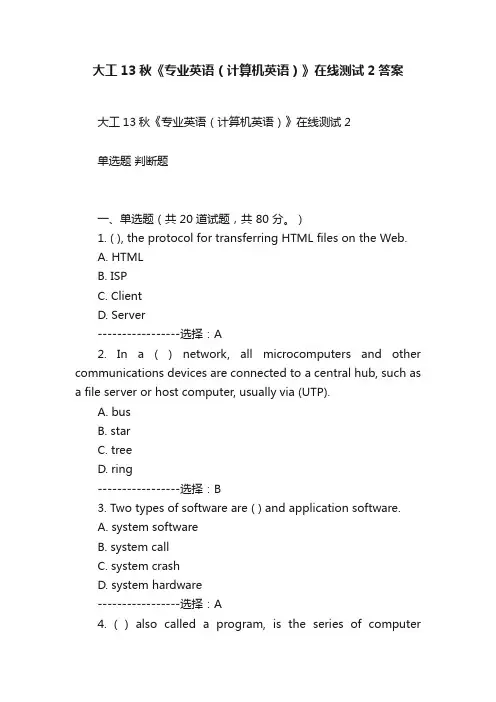
大工13秋《专业英语(计算机英语)》在线测试2答案大工13秋《专业英语(计算机英语)》在线测试2单选题判断题一、单选题(共 20 道试题,共 80 分。
)1. ( ), the protocol for transferring HTML files on the Web.A. HTMLB. ISPC. ClientD. Server-----------------选择:A2. In a ( ) network, all microcomputers and other communications devices are connected to a central hub, such as a file server or host computer, usually via (UTP).A. busB. starC. treeD. ring-----------------选择:B3. Two types of software are ( ) and application software.A. system softwareB. system callC. system crashD. system hardware-----------------选择:A4. ( ) also called a program, is the series of computerlanguage coded instructions that tells the computer how to perform tasks.A. SoftwareB. HardwareC. CompilerD. Interpreter-----------------选择:A5. ( ), short for modulator/demodulator, device that converts digital signals into a representation of analog form(modulation) to send over phone lines;a receiving modem then converts the analog signal back to a digital signal(demodulation).A. ServerB. NetworkC. ModemD. Gateway-----------------选择:C6. Linux is an operating system similar to ( ) that is becoming more and more popular.A. Windows 98B. Windows 2000C. Windows XPD. Unix-----------------选择:D7. ( ) is a device that functions as both a router and a bridge.A. RepeaterB. SwitchC. GatewayD. Brouter-----------------选择:D8. ( ), software used in corporate networks (intranets andextranets) to prevent unauthorized people from accessing the network.A. FirewallB. ModemC. HypertextD. TCP-----------------选择:A9. ( ) programs are used to recover deleted or damaged(corrupted) files.A. Data recoveryB. System callC. System crashD. System software-----------------选择:A10. A ( ) is a highly intelligent device that supports connectivity between both like and unlike LANs,and between LANs and WANs or MANs.A. routerB. repeaterC. switchD. bridge-----------------选择:A11. A ( ) is software that looks at an entire high-level program before translating it into machine language.A. compilerB. interpreterC. instructionD. process-----------------选择:A12. The ( ) is automatically loaded into RAM soon after youturn on, or "boot" the computer.A. application softwareB. operating softwareC. shellD. compiler-----------------选择:B13. A ( ) channel allows simultaneous message exchange in both directions.It really consists of two simplex channels, a forward channel and a reverse channel,linking the same points.A. half-duplexB. full-duplexC. simplexD. none of the above-----------------选择:B14. In ( ) mode, the communication is unidirectional, like a one-way street. Only one of the two stations on a link can transmit;the other can only receive.A. half-duplexB. full-duplexC. simplexD. none of the above-----------------选择:C15. ( ) is the number of times a wave repeats during a specific time interval,that is how many times it completes a cycle in one second.A. AmplitudeB. FrequencyC. Analog signalsD. Digital signals-----------------选择:B16. The CPU executes programs coded in a lower level language called the ( ).A. utility programB. language translatorC. machine languageD. backup-----------------选择:C17. ( ) is indicated by the height of a wave within a given period of time.A. AmplitudeB. FrequencyC. Analog signalsD. Digital signals-----------------选择:A18. ( ), difference between the lowest and highest frequencies transmitted in a particular channel or system.A. AmplitudeB. BandwidthC. BridgeD. Network-----------------选择:B19. In a ( ) network, all microcomputers and other communication devices are connected to a continuous loop.A. busB. starC. treeD. ring-----------------选择:D20. ( ) is an acronym for local area network.It is a group of computers and other devices dispersed over a relatively limitedarea and connected by a communications link.A. LANB. WANC. MAND. None of the above-----------------选择:A大工13秋《专业英语(计算机英语)》在线测试2单选题判断题二、判断题(共 10 道试题,共 20 分。
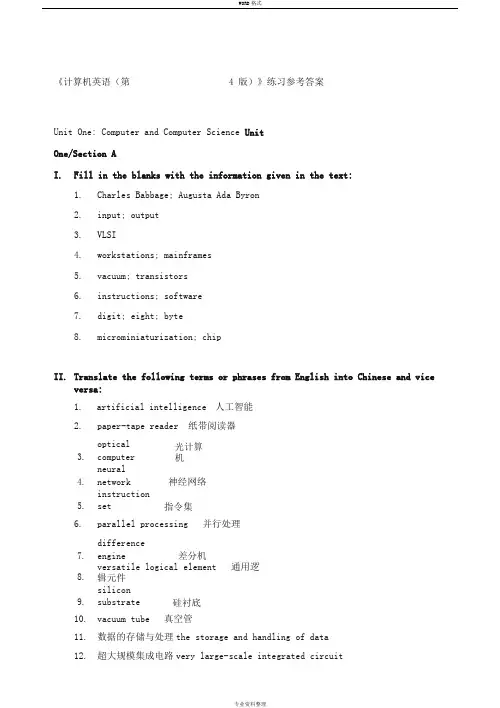
《计算机英语(第 4 版)》练习参考答案Unit One: Computer and Computer Science UnitOne/Section AI.Fill in the blanks with the information given in the text:1.Charles Babbage; Augusta Ada Byron2.input; output3.VLSI4.workstations; mainframes5.vacuum; transistors6.instructions; software7.digit; eight; byte8.microminiaturization; chipII.Translate the following terms or phrases from English into Chinese and vice versa:1. artificial intelligence 人工智能2.paper-tape reader 纸带阅读器3.opticalcomputer光计算机4.neuralnetwork 神经网络5.instructionset 指令集6.parallel processing 并行处理7.differenceengine 差分机8.versatile logical element 通用逻辑元件9.siliconsubstrate 硅衬底10.vacuum tube 真空管11.数据的存储与处理the storage and handling of data12.超大规模集成电路very large-scale integrated circuit13.中央处理器 central processing unit14.个人计算机 personal computer15.模拟计算机analogue computer16.数字计算机digital computer17.通用计算机general-purpose computer18. 处理器芯片processor chip19.操作指令 operating instructions20. 输入设备input deviceIII.Fill in each of the blanks with one of the words given in the following list, makingchanges if necessary:We can define a computer as a device that accepts input, processes data,stores data, andproduces output. According to the mode of processing, computers are either analog or digital .They can also be classified as mainframes, minicomputers , workstations, ormicrocomputers.All else (for example, the age of the machine) being equal, this categorization provides someindication of the compu ter ’speed, size, cost, and abilities.Ever since the advent of computers, there have been constant changes. First-generation computers of historic significance , such as UNIVAC ( 通用自动计算机 ), introduced in the early 1950s, were based on vacuum tubes. Second-generation computers, appearing in the early 1960s, were those in whichtransistors replaced vacuum tubes. In third-generation computers, dating fromthe 1960s, integrated circuits replaced transistors. In fourth-generationcomputers such as microcomputers , which first appeared in the mid-1970s, large-scale integration enabled thousands of circuits to be incorporated on one chip.Fifth-generation computers are expected to combine very-large-scale integration with sophisticated approaches to computing , including artificial intelligenceand true distributed processing.IV . Translate the following passage from English intoChinese:计算机将变得更加先进,也将变得更加容易使用。
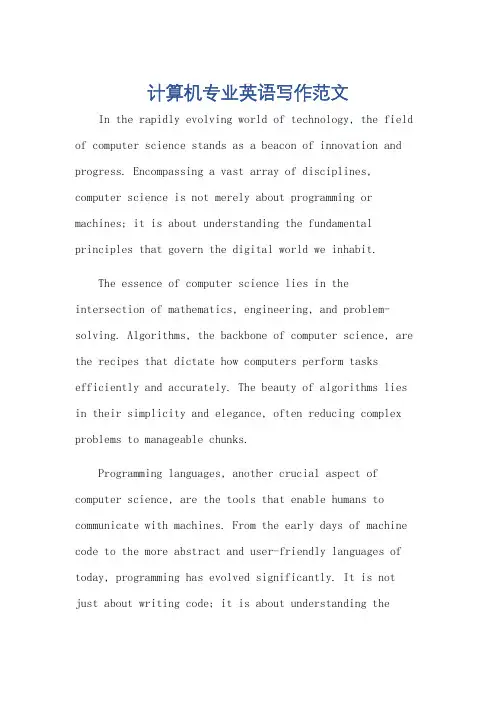
计算机专业英语写作范文In the rapidly evolving world of technology, the field of computer science stands as a beacon of innovation and progress. Encompassing a vast array of disciplines, computer science is not merely about programming or machines; it is about understanding the fundamental principles that govern the digital world we inhabit.The essence of computer science lies in the intersection of mathematics, engineering, and problem-solving. Algorithms, the backbone of computer science, are the recipes that dictate how computers perform tasks efficiently and accurately. The beauty of algorithms lies in their simplicity and elegance, often reducing complex problems to manageable chunks.Programming languages, another crucial aspect of computer science, are the tools that enable humans to communicate with machines. From the early days of machine code to the more abstract and user-friendly languages of today, programming has evolved significantly. It is not just about writing code; it is about understanding theunderlying concepts and applying them effectively to solve real-world problems.Data structures, another crucial aspect, are the building blocks of efficient programming. They help organize and manage data in a way that facilitates quick access and manipulation. Knowledge of data structures is crucial for writing efficient and scalable software.Moreover, computer science is at the forefront of innovation in fields like artificial intelligence, machine learning, and cybersecurity. The development of intelligent machines that can learn and adapt, as well as the creation of secure systems that can protect against cyber attacks, are just two examples of the remarkable advancements inthis field.In conclusion, computer science is not just a discipline; it is a way of thinking. It teaches us to approach problems with a logical and analytical mindset, to break them down into manageable parts, and to findefficient solutions. As we enter an era where technology is becoming increasingly intertwined with our lives, the importance of computer science cannot be overstated. It isnot just a tool; it is a critical skill that will help us navigate the digital world and contribute to its continued growth and development.**探索计算机科学领域:一篇英语写作**在科技迅速发展的世界中,计算机科学领域如同创新与进步的灯塔。
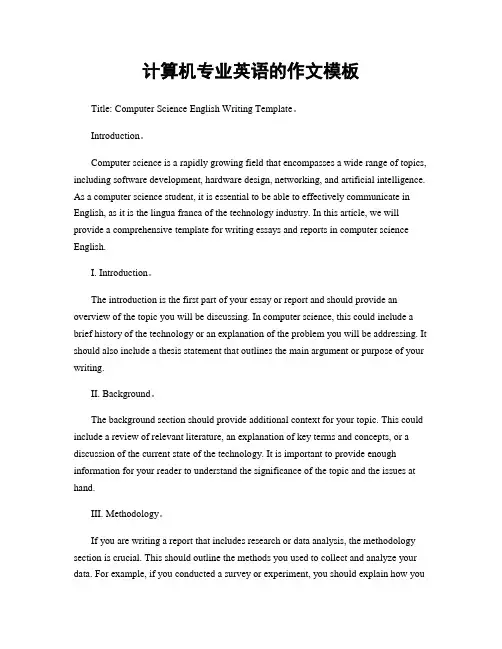
计算机专业英语的作文模板Title: Computer Science English Writing Template。
Introduction。
Computer science is a rapidly growing field that encompasses a wide range of topics, including software development, hardware design, networking, and artificial intelligence. As a computer science student, it is essential to be able to effectively communicate in English, as it is the lingua franca of the technology industry. In this article, we will provide a comprehensive template for writing essays and reports in computer science English.I. Introduction。
The introduction is the first part of your essay or report and should provide an overview of the topic you will be discussing. In computer science, this could include a brief history of the technology or an explanation of the problem you will be addressing. It should also include a thesis statement that outlines the main argument or purpose of your writing.II. Background。
第一篇参考文献AN APPLICATION OF THE FELLEGI-SUNTER MODEL OF RECORD LINKAGE TO THE 1990 U.S. DECENNIALCENSUS记录连接的FELLEGI-SUNTER模型在美国1990年十年人口普查中的应用William E. Winkler and Yves ThibaudeauU.S. Bureau of the CensusAbstract:This paper describes a methodology for computer matching the Post Enumeration Survey with the Census. Computer matching is the first stage of a process for producing adjusted Census counts. All crucial matching parameters are computed solely using characteristics of the files being matched. No a priori knowledge of truth of matches is assumed. No previously created lookup tables are needed. The methods are illustrated with numerical results using files from the 1988 Dress Rehearsal Census for which the truth of matches is known.Key words and phrases : EM Algorithm ; String Comparator Metric ; LP Algorithm; Decision Rule ; Error Rate.摘要:本文介绍了一种电脑匹配人口普查的覆核统计调查的方法。
谈谈计算机专业英语作文{z}Title: The Importance of Computer Science in EnglishEnglish is an essential language in the field of computer science.As technology continues to advance at a rapid pace, the demand for computer science professionals who are proficient in English has also increased.In this essay, we will discuss the importance of computer science in English and the benefits it brings to professionals in the field.Firstly, computer science is a global discipline.English is the lingua franca of the scientific community, and it is no different in the field of computer science.Most research papers, articles, and technical documentation are written in English.Therefore, being proficient in English allows computer science professionals to access and understand the latest research and developments in the field.It also enables them to communicate and collaborate with colleagues from around the world, fostering innovation and progress in the discipline.Secondly, proficiency in English enhances career prospects for computer science professionals.The tech industry is a global industry, and companies often operate in English-speaking countries or have international clients.Being able to communicate effectively in English is a valuable skill that can open up opportunities for professionals to work in diverse settings and with different cultures.It can also help them advance in their careers, as they will be able to participate in international projectsand conferences, and contribute to the global tech community.Furthermore, computer science is heavily dependent on English for its technical jargon and terminology.Understanding and using these terms correctly is crucial for effective communication and collaboration among professionals.Proficiency in English ensures that computer science professionals can understand and contribute to technical discussions, write clear and concise code, and effectively communicate their ideas and findings to others in the field.Lastly, the internet and technology are inherently global and English-dominated.Most websites, software, and online platforms are in English, as it is the primary language used for programming and content creation.Proficiency in English allows computer science professionals to navigate and contribute to these platforms, ensuring that they can stay up-to-date with the latest trends and developments in the field.In conclusion, computer science professionals must have a strong command of English to succeed in their careers.Proficiency in English allows them to access and contribute to the global body of knowledge in the field, enhance their career prospects, effectively communicate with colleagues and clients, and navigate the English-dominated online world.Therefore, it is crucial for computer science students and professionals to invest time and effort in mastering the language.。
拿答案:1144766066答案来源:雅宝题库网()-[大连理工大学]大工20秋《专业英语(计算机英语)》在线作业1试卷总分:100 得分:100第1题,The first generation computers were huge,slow,expensive,and often undependable.T、对F、错更多答案下载:雅宝题库网()第2题,The transistor computer did not last as long as the vacuum tube computer lasted, but it was less important in the advancement of computer technology.T、对F、错正确答案:F第3题,Transistors were a tremendous breakthrough in advancing the computer. T、对F、错更多答案下载:雅宝题库网()第4题,However what really triggered the tremendous growth of computers and its significant impact on our lives is the invention of the microprocessor. T、对F、错更多答案下载:雅宝题库网()答案来源:雅宝题库网(),It wasn't until the 1980's that people began buying computer for personal use.T、对F、错正确答案:第6题,A computer can be broken down into three distinct categories, namelyoutput,input and CPU.T、对F、错更多答案下载:雅宝题库网()第7题,The term 'output' consists of all components that display words and graphics so that a person can see them.T、对F、错正确答案:第8题,The keyboard is classified as a form of output.T、对F、错正确答案:F第9题,Mouse belongs to input.T、对F、错更多答案下载:雅宝题库网()答案来源:雅宝题库网(),CPU is the soul of a computer.T、对F、错更多答案下载:雅宝题库网()第11题,The ENIAC used thousands of( ),which took up a lot of space and gave off a great deal of heat just like light bulbs do.A、vacuum tubesB、integrated circuitsC、chipsD、switches正确答案:答案来源:雅宝题库网(),In 1947 three scientists, John Bardeen, William Shockley, and Walter Brattain working at( )invented the transistor computer.A、BaiduB、MicrosoftC、AT&T's Bell LabsD、Yahoo正确答案:第13题,The fourth generation computers can be characterized by both the jump to monolithic integrated circuits and the invention of( ).A、microprocessorB、transistorC、chipD、circuit正确答案:第14题,The software and hardware components of a computer( ).A、function independentlyB、can never be coordinatedC、rely on each other and support each otherD、none of the above正确答案:答案来源:雅宝题库网(),A location in RAM memory is accessed by its( )A、contentsB、addressC、storage unitD、storage capacity正确答案:第16题,RAM is a( )storage.A、permanentB、flashC、temporaryD、expansion正确答案:第17题,A(n) ( ) mouse emits and senses light to detect movement.A、cordlessB、opticalC、cameraD、microphone正确答案:第18题,The common input devices are the ( ) and the ( ).A、keyboard,printerB、keyboard,microphoneC、mouse,monitorD、mouse,keyboard正确答案:第19题,A computer must include three of following.Which one is not necessary?A、input systemB、output systemC、processing systemD、networking system正确答案:答案来源:雅宝题库网(),Modern operating systems usually come with a ( ).A、application softwareB、GUIC、memoryD、printer正确答案:拿答案:1144766066。
精简指令系统计算机(RISC)对高级语言程序执行性能的研究已经为设计新型处理器体系结构-一精简指令系统计算机提供了指南。赋值语句占据的优势表明应对单纯的数据传送进行优化。还有很多IF和LOOP指令存在,需要优化基本的顺序控制机构,以使流水线作业高效率。操作数引用模式的研究表明,在多个寄存器中保存适当数量的操作数,可以提高性能。 这些研究已经形成了RISC机的一些关键特性:(1)有限的固定格式的指令集;(2)使用大量的寄存器或使用编译器优化寄存器应用;(3)重点优化指令流水线。因为每条指令完成少数的且多为可预测的操作,RISC的简单指令系统适合高效流水线作业。RISC指令系统体系结构也适合于延迟转移技术,在这种技术中,随同其他指令重新安排转移指令以提高流水线效率。虽然RISC系统已经由不同的(企业)集团以各种方式进行了定义和设计,但大多数设计所提出的关键元素还是共同的。 用大量的通用寄存器(或使用编译器技术)来优化寄存器的使用; 有限的简单指令系统; 重点优化指令流水线作业。
1.指令执行特性 为了解RISC倡导者们的推理思路,首先观察一下指令执行的一些特性。所要关心的计算特性如下所述。 所完成的操作:这些操作决定了处理器要完成的功能和处理器与存储器的交互 所用的操作数:操作数的类型和使用频度决定了存储操作数的存储机制和访问这些操作数的编址方式。 执行顺序:决定了控制和流水线的机制 2.大寄存器组的应用 使用寄存器存储的理由在于它是可用的最快的存储器件,比主存储器和高速缓存都快。寄存器组实际很小,通常与算术逻辑部件和控制器放在同一芯片上,而且使用比高速缓存和内存储器短很多的地址。因而需要一种允许最频繁访问的操作数保存在寄存器中并使寄存器-存储器操作降至最少的策略。 有两种可以采用的基本方法,一种基于软件,一种基于硬件。软件方法靠编译程序最大限度使用寄存器,编译程序力图将给定时间周期内最常用的那些变量分配到这些寄存器中。这一方法要求使用复杂的程序分析算法。硬件方法就是简单地使用更多的寄存器,使更多的变量保存在寄存器中供长时间使用。 3.精简指令系统体系结构的特性 尽管精简指令系统结构的可用方法有多种,但对它们而言有一些特性是共同的。 第一个特性是每个机器周期有一条机器指令。一个机器周期定义为,机器从寄存器组中取出两个操作数,完成一种算术逻辑部件运算并将结果存入一个寄存器中所用的时间。RISC机器指令应该不比CISC机上的微指令复杂,并且执行起来也很快。因为简单,单周期指令仅需少量或不需要微代码;机器指令可以是硬连线的。这样指令执行起来比其他机器的类似机器指令要快,因为在指令执行期间它不必访问微程序控制存储器。 第二个特性是,大多数操作应该是寄存器对寄存器的,仅有简单的取(LOAD)和存(STORE)操作访问存储器。这种设计特点简化了指令系统,因而也简化了控制器。例如,一个RISC指令系统可以只包括一两种加法(ADD)指令〔例如整数加,进位加〕;VAX机则有25种不同的加法指令。另一好处是这种体系结构促进了对寄存器使用的优化,使得频繁访问的操作数保存在高速存储器中。 第三个特性是采用简单的编址方式。几乎所有指令都采用简单的寄存器编址。几种附加的方式,如移位和与PC有关的方式可以包括进去。另外,更为复杂的方式可以用简单的方式在软件中合成。再次强调,这种设计特点简化了指令系统和控制器。 最后一个共同特性是采用简单的指令格式。一般来讲,只使用了一种或少数几种格式。指令长度是固定的并按字的边界调整。字段的位置,特别是操作码的位置是固定的。这种设计有很多优点,使用固定字段,操作码译码和寄存器操作数访问可同时进行。简化的格式简化了控制器;因为是按字长单位来读取的,所以,取指令也得到优化。这也表明一条指令不会跨页。
1 网址一:http://anasshad.hubpages.com/hub/save-computer-from-Hackers 网址二:http://kea.hubpages.com/hub/What-is-Phishing 姓名: ** 学号: ************ 分校: 通州
(一)原文 1.
What is Computer Hacking? Computer hacking is a malicious act, so it is important for your computer and data to protect from Hacking. Computer Hacking refers to the process of making malicious modifications to a software or hardware to accomplish an aim outside the original creator's objective. Hackers are usually expert programmers who usually see hacking as a real life application of their skills.
Hacking has become a nuisance in recent times and the protection from hacking has become more complex. Infact, the hackers have become so good that even the software giants are feeling a headache. Nintendo recently reported a loss of $975 million due to privacy and Microsoft has lost an estimated $900 million in five years.
Well, the Giants are not the only targets of these hackers, even common individuals are not safe. The dangers range from little thefts to sponsored terrorism. These include stealing personal information and spying your activities. They can get to your secrets and destroy your credit. The dangers are possibly endless.
How to protect from Hacking Prevention is Better Than Cure. The problem of computer hacking has become really serious. But there are some basic methods which are usually the best to guarantee a Hacker-free system. Here, I am going to introduce some basic tips to save your computer and data from hackers.
Using Antivirus Software Antivirus software are one of the basic tools for your data and computer to protect from hacking. Antivirus software act as a protecting net that catches any potential threat before it reaches your system. They can prevent unauthorized access to your computer, protects your system from viruses and cloaks your data ports from intruders searching for any opening. The dangers range from little thefts to sponsored terrorism. These include stealing personal information and spying your activities. 2
Nowadays anti virus software are completely automated. Go for the best when choosing anti virus software and make sure that you scan your system for viruses atleast once a week. Norton antivirus from Symantecis one of the leading products in the industry. Avastis another great antivirus tool to protect from hacking.
Using Firewall What is a Firewall? A firewall is a set of programs located at the network gateway server which protects a private network from unauthorized access from other networks. The term firewall is originally referred to a wall intended to confine a fire.
A firewall protects your computer from offensive websites and potential hackers. It keeps your data and information safe from unwanted intruders. Firewalls are designed to prevent unauthorized access to your network, much like a locked door.Thus firewall is a vital tool for your strategy against hackers so don't forget to set up one for your system. Microsoft has a built-in firewall software but you can also try the Symantec firewall.
Using Anti Spyware Software What is a Spyware? A spyware is a self installing software which secretly gathers information about a person's computing activities such as surfing habits and viewed sites. Spywares are truly a hacker's tool, not only collecting personal information but also interfering with user control by installing additional software and redirecting web browsers.
Anti spyware software are designed to save your computer from hackers. They not only protect your computer by detection and removal of spywares but also preventing automatic installation of these malicious programs. Spysweeperis a great anti spyware software to guarantee a spyware free computer.
Email Security Email is one of the leading hacker's tools. Hackers use emails to transmit malicious software to your computer. Emails are usually very cheap which gives the hackers loads of opportunities. One of the basic tips to prevent hacking is to be extra careful with emails. The most important tip is that you should never hand out your real email address to a stranger. Never open an email arriving from an unknown source and never try to open an attachment with an email if you don't know the sender. Aviraantivirus is a useful tool to filter your emails for potential threats as well as provide premium protection for your computer.
Software updates Hackers are always searching for security gaps in your system. Anti virus and anti spyware software usually lose their effectiveness with time as new and more advanced malicious programs are created by hackers.